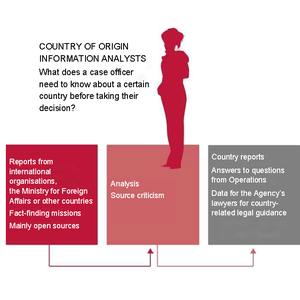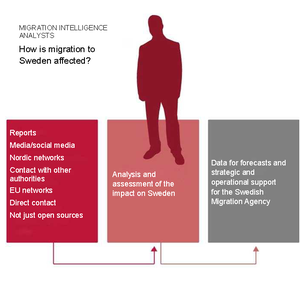How is the Swedish Migration Agency monitoring the world around us?
The way the Swedish Migration Agency operates is largely determined by events beyond Sweden’s borders. The Swedish Migration Agency needs information to be able to assess future developments in migration and for taking decisions that are legally secure.
How many people will apply for a work permit – or protection – in Sweden next year? How dangerous is the situation in Afghanistan following the Taliban’s takeover? And what will happen in Ukraine? The Swedish Migration Agency must be able to provide thorough answers to these kinds of questions.
This is why the Agency has a unit that assesses various aspects of migration with the help of two analyst groups – country of origin information analysts and migration intelligence analysts.
Country of origin information analysts – crucial for asylum examinations
The country of origin information analysts study a wide range of information from sources such as organisations, authorities and legislation. They use this information to describe the conditions in a particular country. The information needs of the Swedish Migration Agency’s determine which countries or regions form the basis of a country report, which is then published in the external database, Lifos External link..
External link..
The country reports are used by those processing and taking decisions in individual cases. They also form an important component of the assessment basis when lawyers at the Swedish Migration Agency establish legal opinions, part of the country-based legal guidance necessary to process cases efficiently, uniformly and in a legally secure manner.
However, the Agency takes individual decisions on asylum cases. These decisions are based on the circumstances of a specific case that determine whether a person will receive protection in Sweden or not.
A country report may be about Somalia and address the current situation in the country in terms of safety, human rights and humanitarian conditions. What have other countries and organisations established about the situation? Are there any people, such as women, LGBTQI people, ethnic groups
or religious communities who are particularly vulnerable? Which regions are more or less safe? These are some of the questions that a country report can answer when a person from Somalia is seeking protection in Sweden.
Migration intelligence analysts create strategic and operational data
The migration intelligence analysts have a different perspective. They are tasked with creating a basis to assess short and long-term developments in migration to Sweden. They analyse developments in the world around us and provide data to the Agency in the form of situational analyses, reports and assessments. This data is used in the Swedish Migration Agency’s prognoses (in Swedish), as well as the strategic and operational work that keeps the Agency running efficiently.
The migration intelligence analysts investigate what forces people from different countries of origin. They often collaborate with country of origin information analysts. Migration intelligence analysts also examine the accessibility of migration routes, Sweden’s attractiveness as a destination country and the situation in other major European destination countries. Political decisions on migration – both in Sweden and abroad – can have
a major impact on the number of people seeking protection in the country. Sweden’s proportion of the total number of asylum seekers in Europe has decreased over time, and the migration intelligence analysts have a particular focus on the political dimension at both national and EU level.
Together with other experts at the Agency, they analyse the situation in other non-asylum categories to determine how these will develop over time. Work permits are one example of where developments are analysed based on legislation, economic situation and external factors.
 Zoom image
Zoom imageThe map is an example of a typical Frontex document. It illustrates how irregular migration to the EU changed between 2022 and 2023. The term ‘irregular migration’ is used to describe people from a non-EU country who cross borders without meeting the legal requirements to enter the Union. The image shows the primary routes – the routes taken from irregular migrants to enter the EU from non-EU countries. It shows, for example, that migration via the Eastern Mediterranean increased by 55 per cent in 2023 compared to 2022, and that 60 073 people crossed the border into the EU.
Routes illustrated from left to right:
Western Africa
Western Mediterranean
Exits towards the UK
Central Mediterranean
Western Balkan
Eastern Land Border
Eastern Mediterranean

How many different maintenance requirements are there?
In 2023, the government decided to raise the maintenance requirement for work permits, which has led to many questions for the Swedish Migration Agency. However, there are different types of maintenance requirements depending on what you are applying for. In this part of the Swedish Migration Agency answers, we explain what the maintenance requirements are and who needs to meet them.
.png)
Unaccompanied minors – how have asylum applications evolved over the past ten years?
From tens of thousands to a few hundred per year – the number of asylum-seeking unaccompanied minors and young people who come to Sweden has declined sharply over the past decade.

How a residence permit for studies works
In recent years, the number of people from other countries who want to study in Sweden has increased. Which countries are the students from? And how long do they have to wait for a decision on a residence permit? In this article, we explain what applies to those who want to study higher education in Sweden.

